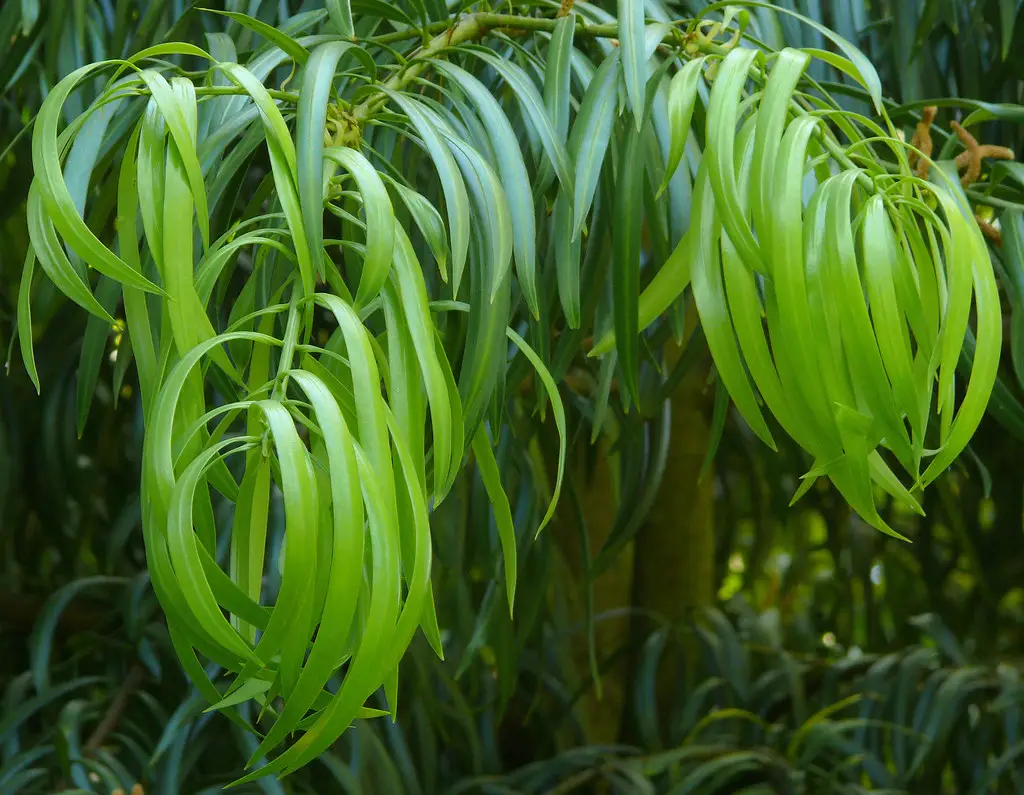Podocarpus, commonly referred to as the Podocarpus Pine or Buddhist Pine, is a genus of evergreen coniferous trees and shrubs. It belongs to the family Podocarpaceae and is native to various regions, including Southern Hemisphere countries like New Zealand and South America. With its attractive foliage and graceful growth habit, Podocarpus species are often used in landscaping, bonsai, and traditional gardens.
The unique foliage of Podocarpus is one of its standout features, consisting of dense, needle-like leaves that are soft to the touch. The plant also produces inconspicuous flowers and fleshy, berry-like cones, adding further interest. It can be grown both indoors and outdoors and is admired for its adaptability and ease of care.
Not only does Podocarpus serve as an ornamental plant, but it also holds cultural significance in various traditional practices. It’s often associated with tranquility and peace and is used symbolically in some spiritual practices. Its wood is also valuable for various applications, contributing to its commercial importance.
| Aspect | Details |
|---|---|
| Common Names | Podocarpus Pine, Buddhist Pine, Yew Pine |
| Botanical Name | Podocarpus spp. |
| Family | Podocarpaceae |
| Plant Type | Evergreen Tree/Shrub |
| Mature Size | Varies by species; typically 8-50 feet tall |
| Sun Exposure | Full Sun to Partial Shade |
| Soil Type | Well-drained, Acidic to Neutral |
| Hardiness Zones | 7-11 |
| Native Area | Southern Hemisphere, including New Zealand and South America |
Podocarpus Care
Podocarpus is a versatile plant that can be adapted to various growing conditions. It’s equally at home as an indoor houseplant as it is in a garden landscape. Its care primarily revolves around providing the right light, soil, and water conditions and regular pruning to maintain shape and size.
When planted outdoors, Podocarpus can thrive in various climates and will grow into a substantial tree or shrub. As an indoor plant, it’s often grown as a bonsai or a small decorative shrub. It’s hardy and tolerates a range of care routines, making it suitable for both beginners and expert gardeners.
Light Requirement for Podocarpus
Podocarpus grows best in full sun to partial shade. While it can tolerate a fair amount of shade, too little light may result in sparse and leggy growth. When grown indoors, placing it near a bright window with filtered light ensures healthy growth.
Soil Requirements for Podocarpus
The soil should be well-drained and slightly acidic to neutral. While Podocarpus is adaptable to different soil types, avoiding heavy clay or overly soggy soil is essential to prevent root rot.
Water Requirements for Podocarpus
Podocarpus prefers a consistent watering schedule, especially during the growing season. Allowing the soil to dry slightly between waterings is advisable. Over-watering should be avoided as it can lead to root problems.
Temperature and Humidity
Podocarpus prefers a mild to warm climate, thriving in temperatures ranging from 60-80°F (15-27°C). It can tolerate some frost but should be protected from extreme cold. Indoor plants prefer moderate humidity but can adapt to average household conditions.
Fertilizer
A balanced, slow-release fertilizer can be applied in the spring and summer to promote growth. It’s not necessary to fertilize excessively, as Podocarpus doesn’t have heavy nutrient requirements.
Pruning Podocarpus
Pruning helps maintain the desired shape and size of Podocarpus. Regular trimming encourages dense growth, especially when grown as a hedge or screen. Any dead or diseased branches should be removed as needed.
Propagating Podocarpus
Podocarpus can be propagated through cuttings or by layering. Cuttings should be taken in late summer and rooted in a well-draining medium. Layering involves bending a branch to the ground and covering a part of it with soil to encourage rooting.
How To Grow Podocarpus From Seed
Growing Podocarpus from seed can be a slow process. Seeds should be sown in a well-draining mix and kept warm and moist. Germination may take several months, and seedlings grow slowly.
Common Pests & Plant Diseases
Scale Insects
These pests can be treated with insecticidal soap or neem oil.
Root Rot
Caused by over-watering; can be prevented by proper watering practices.
Common Problems With Podocarpus
Yellowing Leaves
Often a sign of over-watering or poor drainage. Adjust watering habits and ensure well-drained soil.
Leggy Growth
May be due to insufficient light. Increase light exposure for denser growth.
Frost Damage
In colder zones, frost can cause damage. Protect with a frost cloth or move indoors if possible.
Pro Tips
- Podocarpus makes an excellent privacy screen or windbreak when planted in a row.
- For indoor bonsai, regular pruning and training are essential to maintain shape.
- Avoid planting in areas prone to standing water to prevent root problems.
- Consider soil pH, as Podocarpus prefers slightly acidic to neutral soil.
- Be patient with growth, especially when propagating from seed or cuttings, as Podocarpus grows relatively slowly.




